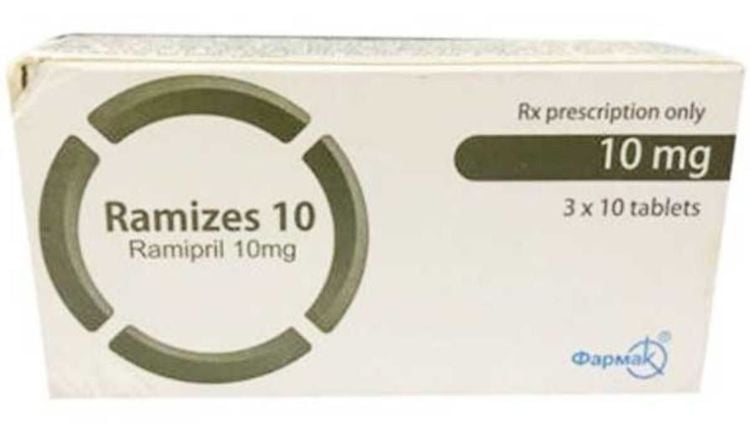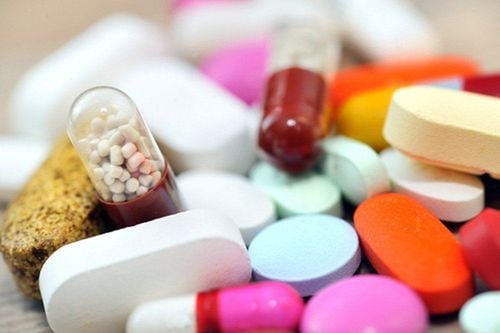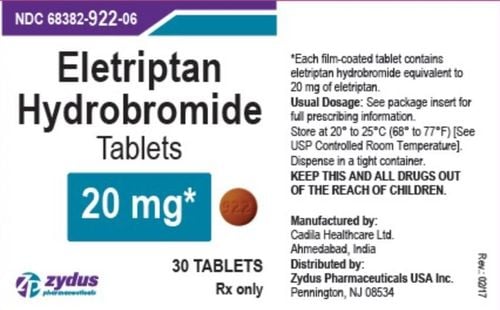This is an automatically translated article.
Blood pressure diseases such as hypertension, low blood pressure, metabolic cardiovascular disease are the most common diseases today, and are common in middle age. There are many drugs on the market to treat high blood pressure, including Ramizes 10 mg. Let's find out detailed information about the effects of ramizes 10 in the article below.
1. What is Ramizes 10 mg?
Many scientific evidences have proven that people with obesity, smoking, eating a lot of salt, complications from kidney disease, heart disease, inactivity, genetics,... are at risk for high blood pressure and cardiovascular disease. High blood pressure is caused by too much pressure on the walls of the arteries, causing high blood pressure. Hypertension is a chronic disease, often requiring lifelong treatment, and if not treated well, can easily lead to cerebrovascular accident, acute heart failure or stroke. This is one of the leading causes of death for patients.
Ramizes 10 is currently an indispensable option for patients with hypertension. The drug works to regulate blood pressure in the body to bring blood pressure to a state of balance and prevent dangerous complications for patients.
1.1. Pharmacodynamics of Ramizes 10 Pharmacotherapeutic group: Drugs acting on the renin-angiotensin system, ACE inhibitors, ATC code C09AA05.
1.2. Mechanism of action Ramizes 10 Ramiprilat, the active metabolite of the precursor ramipril, inhibits the enzyme dipeptidyl carboxypeptidase I (angiotensin converting enzyme; kininase II). This enzyme catalyzes the conversion of angiotensin I to the active vasoconstrictor angiotensin II in plasma and organ tissues. It then degrades and reduces the formation of angiotensin II and inhibits the breakdown of bradykinin leading to vasodilation.
Since angiotensin II also stimulates aldosterone release, ramiprilat causes a decrease in aldosterone secretion.
1.3. Pharmacokinetic information Ramizes 10 Following oral administration of Ramizes 10, it is rapidly absorbed from the gastrointestinal mucosa into the general circulation: the highest plasma concentrations of ramipril are achieved within one hour. In the presence of food in the gastrointestinal tract, the extent of absorption of Ramizes 10 is not significantly affected. The bioavailability of the active metabolite ramipril following administration of 2.5 mg and 5 mg of ramipril is 45%.
After 2-4 hours after taking Ramizes 10, the concentration of Ramipril in the blood plasma reaches the highest level.
The serum protein binding rate of Ramipril is about 73% and that of ramiprilat about 56%.
Ramipril is almost completely metabolised to ramiprilat and the diketopiperazine esters, diketopiperazine acid and the glucuronide of ramipril and ramiprilat.
Metabolites are excreted mainly by the kidneys. Due to its strong binding, saturation to ACE, and slow dissociation from the enzyme, ramiprilat exhibits a prolonged terminal elimination phase with very low plasma concentrations.

Ramizes 10 là một trong các loại thuốc điều trị tăng huyết áp
2. The effects of the drug Ramizes 10 mg
2.1. What are the uses of Ramizes 10? Because Ramize 10 inhibits the ECA enzyme, Angiotensin II is reduced and plasma vasopressin is reduced, reducing peripheral circulatory resistance and causing vasodilation. Ramize 10 drug causes selective vasodilation in important tissues such as coronary artery, kidney, brain, adrenal.... vascular function. Ramize 10 has no direct effect on the sinus node, does not change heart rate, although it does lower blood pressure due to direct or indirect parasympathetic stimulation via prostaglandins or loss of sympathetic reflexes of Angiotensin II. on the pressure reflex arc. Ramize 10 drug reduces hypertrophy and fibrosis of the ventricles, interventricular septum. Ramize 10 helps increase sodium excretion, preserve potassium by reducing the effect of aldosterone, so it lowers blood pressure. Ramize 10 increases renal circulation leading to increased glomerular filtration rate and increased uric acid excretion. Ramize 10 increases insulin sensitivity (insulin resistance) and increases glucose absorption. 2.2 Note the effects of Ramizes in some other cases All manufactured pharmaceutical products have the main effect to treat a specific medical condition, in addition there are a number of other effects that will be specified in the user manual. Although, Ramizes 10 may have some other effects that are not listed on the approved label, so you should only use this medicine to treat certain other conditions when directed by your doctor.
3. How to use Ramizes 10 mg
3.1. The use cases of Ramizes 10 are: The drug ramizes 10 is indicated for the treatment of the following:
Treatment of hypertension Ramizes 10 helps prevent metabolic cardiovascular disease by reducing the incidence of cardiovascular disease. and cardiovascular or diabetes-related deaths are associated with cardiovascular risk.
Treatment of kidney disease Ramizes 10 helps in the treatment of diabetes mellitus accompanied by glomerulonephritis with impaired function due to microalbuminuria. In addition, Ramizes 10 is indicated for the treatment of diabetic nephropathy with proteinuria in patients with at least one cardiovascular risk factor, or non-diabetic nephropathy diagnosed by proteinuria ≥ 3g/ day.
Treatment of Symptomatic Heart Failure Ramizes 10 provides secondary prevention after acute myocardial infarction by reducing mortality from the acute phase of myocardial infarction in patients with clinical signs of myocardial infarction. clinical heart failure at onset > 48 hours after acute myocardial infarction.

Thuốc Ramizes cần dùng theo chỉ định của bác sĩ sau khi người bệnh được thăm khám
3.2. Dosage of ramizes 10 mg 3.2.1. In adults Patients being treated with diuretics When starting treatment with Ramizes 10, the patient's blood pressure showed signs of decreasing. However, patients need to be cautious because the drug can cause volume depletion or salt concentration. Therefore, if the patient is on diuretic therapy, it is possible to temporarily stop taking the diuretic for 2 to 3 days before starting treatment with Ramizes 10.
For patients with persistently high blood pressure diuretics, treatment with Ramizes should be initiated at a dose of 1.25 mg, and the patient should be monitored for renal function and serum potassium. Subsequent doses of ramizes should be titrated according to the goal of antihypertensive therapy.
Hypertension Ramizes 10 can be used alone or in combination with other classes of antihypertensive agents. Therefore, patients should use the recommended initial dose of 2.5mg per day.
In patients with a strongly activated renin-angiotensin-aldosterone system, an excessive decrease in blood pressure may occur after the initial dose of Ramizes. Therefore, a starting dose of Ramizes of 1.25 mg is recommended in such patients under medical supervision. The dose may then be doubled at 2 to 4 week intervals to achieve blood pressure goals and the maximum dose of Ramizes is 10 mg per day.
Prevention of cardiovascular disease With the starting dose of Ramizes is 2.5mg once a day, and depending on the patient's tolerability, the dose should be increased with subsequent doses. After one or two or three weeks of treatment, the dose of Ramizes should be doubled, to a maintenance dose of 10mg once daily.
In patients with diabetes and at least one cardiovascular risk With an initial dose of 2.5 mg once daily, and depending on the patient's tolerability, the dose should be increased between doses. next. After one or two or three weeks of treatment, the dose of ramizes should be increased by 5 mg ramipril and then to 10 mg ramipril once daily.
Symptomatic heart failure For patients stabilized on diuretics, the starting dose of Ramizes is 1.25 mg daily, and the dose is doubled every one to two weeks to the maximum daily dose. day is 10mg ramizes per day/once.
Secondary prevention after acute myocardial infarction and heart failure In patients with myocardial infarction who are clinically and hemodynamically stable after 48 h, the initial dose of ramizes is 2.5 mg twice daily for 3 days. day. If the patient cannot tolerate the 2.5mg dose, Ramizes 1.25mg twice a day should be used. After 2 days, increase to 2.5mg and 5mg twice a day. If the dose cannot be increased to 2.5 mg twice a day, treatment with ramizes should be discontinued.
Patients with renal impairment Daily dose in patients with renal impairment should be based on creatinine clearance:
If creatinine clearance is ≥ 60 ml/min, no initial dose adjustment (2.5 mg/day) is necessary. ; The maximum daily dose is 10mg. If creatinine clearance is in the range of 30-60ml/min, no initial dose adjustment (2.5mg/day) is necessary; The maximum daily dose is 5mg.
If creatinine clearance is between 10-30ml/min, initial dose is 1.25mg/day and maximum daily dose is 5mg.
Patients with hepatic impairment In patients with hepatic impairment, treatment with ramipril should only be initiated under close medical supervision and the maximum daily dose is 2.5 mg ramipril.
3.2.2. Elderly The initial dose should be lower and subsequent dose titration should be more gradual because of the higher likelihood of undesirable effects, especially in elderly and frail patients. An initial dose reduction of 1.25 mg ramipril should be considered.

Người cao tuổi nên dùng thuốc ramizes 10 mg theo liều lượng chỉ định
4. Undesirable effects of the drug Ramizes 10 mg
Using Ramizes also has some of the following adverse reactions that may appear during the treatment of the disease:
Common symptoms: Increased blood potassium levels, feeling of headache, dizziness, low blood pressure , syncope, gastrointestinal infection, gastrointestinal disturbance, abdominal bloating, dyspepsia, diarrhea, nausea, vomiting, chest pain, fatigue. Uncommon symptoms: Anorexia, depressed mood, anxiety, nervousness, restlessness, sleep disturbances, visual disturbances including blurred vision, paresthesia, ... Family members and patients should contact Contact your doctor or specialist pharmacist immediately if you feel any adverse symptoms after using Ramizes 10 mg.
Please dial HOTLINE for more information or register for an appointment HERE. Download MyVinmec app to make appointments faster and to manage your bookings easily.













